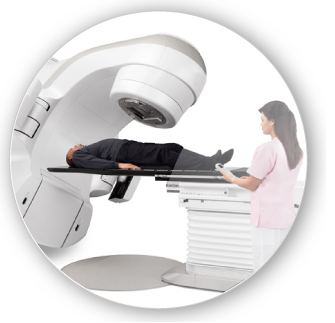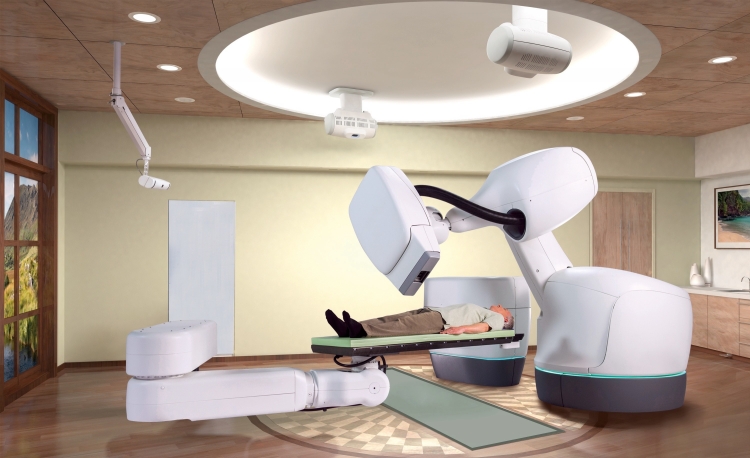WHAT IS RADIATION ONCOLOGY?
Radiation oncology is a medical specialty. The goal is to use irradiation to treat disease in the human body. A medical machine (linear accelerator), or a radioactive source is used to create irradiation. This irradiation is then sent to the human body using a variety of systems that ensure that the right amount reaches the right part of the body.
Radiation oncology is a very precise and modern specialty, with high-quality standards, secure machines, and excellent results obtained thanks to a multidisciplinary approach.

Radiation oncology is very precise
Thanks to advanced computer technology, it is now possible to send the irradiation in a set of narrow beams exactly to the area that needs to be treated. Because this area is to be found in the human body, that moves on the inside and the outside, measures are taken to immobilize the body. There is also a system to check if the patient is exactly placed on the table as planned, and if organs to be treated have not moved inside the body. For instance, a mini-CT scan is taken just before the start of the treatment. This is just one example of a long series of precision measures taken to make the treatment very exact.
Radiation oncology is a modern technology and discipline
Rather than only using human skills, radiation oncology is based on the use of advanced and automated computerised systems. Progress in information technology and medical imaging over the last years has completely changed the way radiation oncology is organised.

Radiation oncology has high-quality standards
Before, during and after a radiation oncology treatment the medical and physics team uses systems to quantify exactly what is needed for the patient and to ensure that the treatment given complies with what was prescribed. This involves advanced imaging to check if the patient is correctly positioned on the treatment table, verifying if the treatment beam delivers exactly the required dose at the surface of the patient, and dozens of other quality measures. By doing so, radiation oncologists go beyond quality initiatives taken in many other medical specialties.
Radiation treatments can be given in a series of ‘fractions’
Usually, the irradiation dose is given over a number of days. The dose is expressed in ‘Gray’, and each treatment is called a ‘fraction’. So to give a dose of 20 Gray, 5 consecutive fractions of 4 Gray can be administered for instance. It is also possible to give the dose of 20 in 10 days (10 fractions of 2 Gray). This does however not give the same results: making the treatment shorter (more condensed, this means fewer fractions but a higher dose per fraction) can increase the effectiveness of the irradiation, but can in some cases also change the side effects. Because of the very high precision of the treatments, these side effects are now often less important than a few years ago.
Radiation therapy for malignant and for benign disease
A radiotherapy treatment is usually prescribed for a benign or a malignant tumour. There are some exceptions, where irradiation is used to treat other diseases than tumours.
Radiation therapy a part of a multidisciplinary approach
A radiotherapy treatment can be given alone, but can also be part of a set of treatments. For instance, a cancer can be treated by surgery first, and then irradiation is used after the surgery to decrease the risk the tumour will recur. To further reduce this risk, also of the tumour recurring elsewhere in the body, chemotherapy can be added. Many other examples of combined therapy exist, with different roles for radiation, chemotherapy, hormonal therapy and surgery. In 'Is radiation therapy a possible treatment for me?', you can read more of the combination of treatments.
Radiation therapy is a team effort
A radiotherapy treatment is prescribed by a radiation oncologist. This physician works in a team with medical physicists who calculate the treatment and assure that correct dose is given. The nursing staff and technologists will operate the treatment machine and place you on the treatment table. You can read more in Who is who in radiation oncology?.
